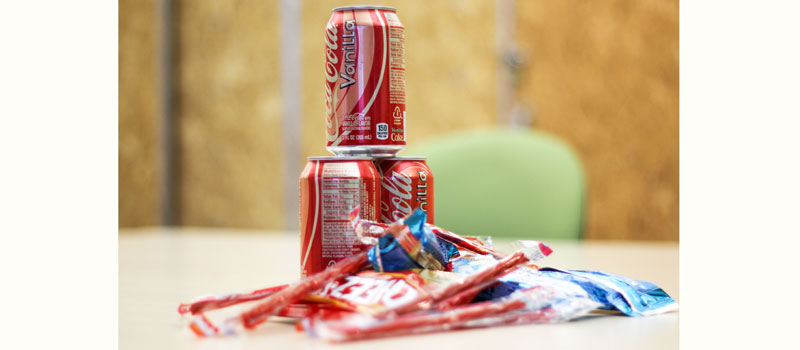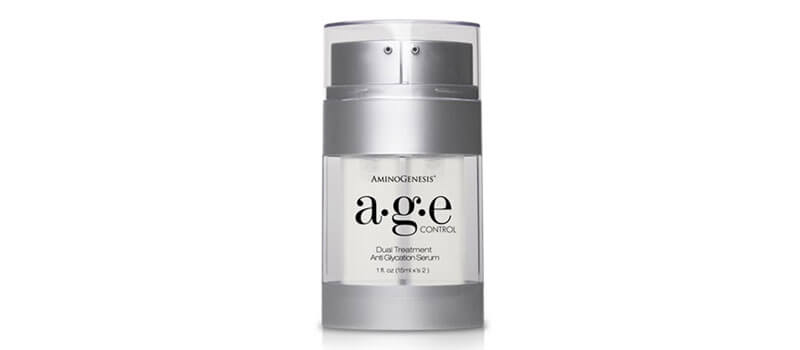Literally thousands of press releases cross my desk each month now, but AminoGenesis Age Control Anti-Glycation Serum ($49.95, FutureDerm.com/Shop) really stood out. AminoGenesis Age Control Anti-Glycation Serum is one of the very first products to combat glycation, rather than signs of sun damage. Glycation make your skin less resilient and supple as you age, giving you skin that no longer “bounces back.” Glycation also results in skin appearing thinner and possibly sagging more as well, due to the damaged state of collagen.
Because it fights a new cause of aging, AminoGenesis Age Control Anti-Glycation Serum is the perfect addition to every skin care fanatic’s regimen — especially during times where you’re eating and overindulging too much (i.e., the holidays!)
What is Glycation?
I’ve never been much of a sweets girl. It’s always salty — salty chips, salty spicy dishes, you name it.
I used to think that got me off the hook when it came to things like high blood sugar, but it turns out that the vast majority of salty snacks have a high glycemic index score, indicating that they turn to sugar almost immediately after they hit your bloodstream. Even worse, excess of any carbohydrate turns into sugar in your bloodstream. Not only does regularly overloading your body this way lead to obesity over time, but it also leads to a chronically-elevated blood sugar level. This is linked to nearly every chronic condition in the book, from heart disease to diabetes.
The skin is no different. When you are constantly overloading sugars into your system, this causes the collagen in your skin to age faster. It’s a process known as glycation.
How Does Excess Sugar Age the Skin?
Do me a favor: The next time you see a child, lightly press on her cheek. Almost instantaneously, the skin springs back, light and elastic. It’s a beautiful thing.
Conversely, if you see an elderly person and press on his cheek, you will notice the skin is paper-thin. It does not spring back readily. Some elderly skin is so damaged, it will actually stay imprinted for a noticeable amount of time (say seconds). This is due to damaged collagen. Years of excess sun exposure cause collagen to break down, damaging valuable DNA, and causing what skin cells are rejuvenated to be produced at a slower rate. To a lesser extent, excess sugar will also age the skin, causing cross-links in the collagen that make it less light and elastic.
For those of you who are especially scientifically curious, excess sugar ages the skin in a very specific process:
1. A blood sugar glycates (attaches to) a protein molecule, forming a Schiff base.
2. The Schiff base either falls apart or forms a more stable product called an Amadori product. Examples of Amadori products include the molecule used to measure blood sugar levels, glycated hemoglobin (Hb1ac), in red blood cells.
3. The Amadori product forms an advanced glycation product (AGE), either directly or through the action of oxoaldehydes, such as methylglyoxyal.
4. The advanced glycation endproduct (AGE) undergoes glycoxidation, a process that is accelerated by the presence of free radicals. This is the super-dangerous part: Through glycoxidation, AGEs cross-link into a second, neighboring protein. These cross links have proven to be responsible, at least in part, for the hardening of cardiovascular structures, improper filtering of the kidneys, and, when the AGE is glucosepane, the hardened, stiffened collagen within aged skin. Cross links of the AGE glucosepane alter the structure of the collagen within the skin and accumulate as you age, progressively making collagen harder and more inflexible.
How Much of a Problem is Glycation?
It is well-established that the vast majority of skin aging is caused by sun damage. We may associate wrinkles, fine lines, age spots, thinning skin, sagging skin, and a sallow complexion with age; but in truth, these are signs of cumulative DNA damage and slowed cellular turnover as a result of years of sun exposure. This is mostly because the sun causes your skin to release damaging free radicals.
In that light, glycation is not as much a concern. Glycation won’t cause your skin to wrinkle, have age spots, or look less luminous or bright as you age. Glycation will, however, make your skin appear thinner and possibly sag more, due to the damaged state of collagen.
Albizia julibrissin: Patent-pending, May Combat Skin Glycation
Albizia julibrissin, also known as Silk Tree or Mimosa of Constantinople, is a tree native to East Asia and South America, but it was spread by the man on almost every continent (US Patent). It has been reported in various reputable journals to have anti-tumor and anti-inflammatory properties (Biochemistry and Medicinal Letters, Carbohydrate Research, Glycoconjugate Journal).
It has been reported that Albizia Julibrissin has effects against glycation, in two different ways:
First, a preventive effect against glycation, to prevent its implementation;
Second, a reparative effect, called a “deglycating” effect or of “de- glycation”. This means that Albizia julibrissin can neutralize or detoxify the products as they are leading up to glycation, leading to a reparative effect on tired skin with in particular a loss of radiance and suppleness (US Patent).
Albizia julibrissin is hard to find in skin care products, and AminoGenesis Age Control Anti-Glycation Serum is one of the only products I’ve found with the ingredient. Truly awesome!
Cyclopentasiloxane and Cyclohexasiloxane: Lightweight Hydration, Skin-Priming Effects
![]()
Cyclopentasiloxane is a silicone. Yes, I’m holding a cube of silicone and standing in front of a periodic table. I’m just cool like that.
Silicones have a specific set of chemical properties, including a large size and significant spacing between each molecule, that enable them to form a molecular lattice on the skin.
![]()
This lattice will allow the silicones to set on the surface of your skin as a moisturizer and conditioner, while enabling ingredients like antioxidants, AHAs, fatty acids, and plant extracts to reach the surface of your skin.While beneficial ingredients will eventually traverse through heavier products, like the new skin care oils and older products with petrolatum and mineral oil bases, it is a shorter process with silicones, so the effects happen faster, and with less occlusion (suffocating) of the skin. On the other hand, beneficial ingredients reach the skin even faster when they are embedded in a solvent like alcohol, but low-molecular weight alcohols do not have hydrating properties for the skin. So silicones can provide a happy medium that is suitable for just about all skin types.
As far as silicones go, the cyclopentasiloxane and cyclohexasiloxane are fairly lightweight. This means that those with normal to oily skin can get away with just using AminoGenesis Age Control Anti-Glycation Serum on its own, whereas those with normal to dry skin may wish to apply AminoGenesis Age Control Anti-Glycation Serum first, followed by a moisturizer.
Personal Use and Opinions
AminoGenesis Age Control Anti-Glycation Serum has a lightweight texture. It is clear and glides across the skin. It absorbs fairly well for a silicone-based serum, and lays atop the skin smooth, without any lingering stickiness or tackiness. It does not have a scent.
Bottom Line
99% of the skin care products out there fight signs of sun damage, but AminoGenesis Age Control Anti-Glycation Serum takes it a step further and fights glycation, that process that occurs naturally over time and results in sagging, inelastic, paper-like skin. I’m a big fan of AminoGenesis Age Control Anti-Glycation Serum, and recommend it highly. For those with dry skin, put another moisturizer over top; for those with oily skin, you should be good!
Love it!
Product Rating: 9/10. (High concentration of proven-effective ingredients: 3/3. Unique formulation or new technology: 3/3. Value: 3/3. Sunscreen: 0/1).
Directions
Apply AminoGenesis Age Control Anti-Glycation Serum to freshly cleansed and dry skin before any other products are applied. Use Day formula in the morning and Night formula in the evening. Wait 2 minutes before applying other products. Review ingredient listing on box for known allergies. Discontinue use if irritation occurs.
Ingredients
Ingredients: Water, Di-PPG2-Myreth-10 Adipate, Albizia julibrissin (2% am formula, 4% pm formula), Glycerin, Cetearyl Alcohol (and) Dicetyl Phosphate (and) Ceteth-10 Phosphate, Diethylene Glycol Monoethyl Ether, Cyclopentasiloxane (and) Cyclohexasiloxane, Cetearyl Alcohol, Steareth-10, Phenoxyethanol, Steareth-2, Carbomer, Postassium Sorbate, Sodium Hydroxide.








